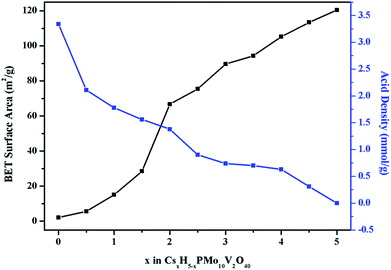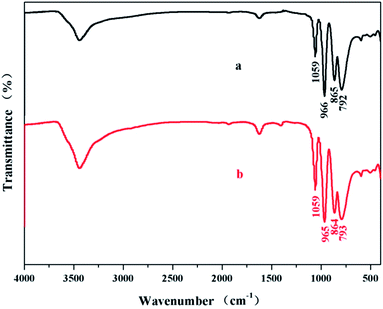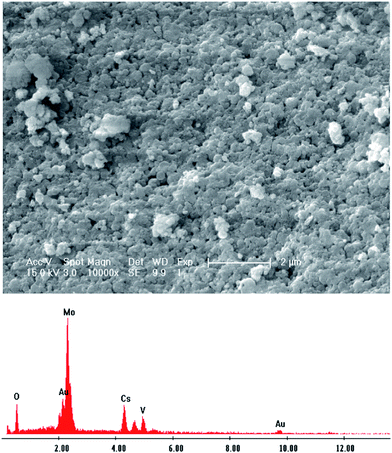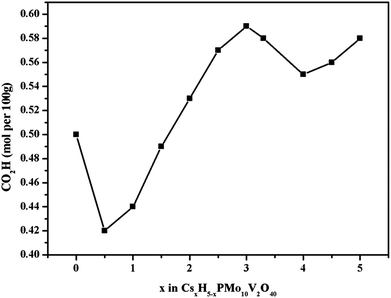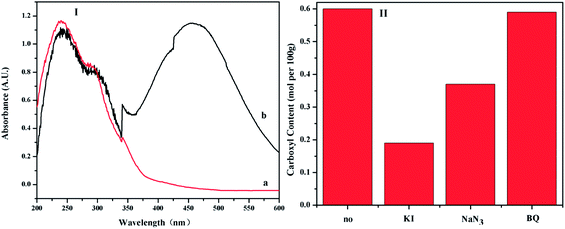Effect of Cs content on CsxH5−xPMo10V2O40 properties and oxidative catalytic activity on starch oxidation by H2O2†
Xiaoli Chen,
Yue Liu,
Hang Wang,
Mengjia Yuan,
Xiaohong Wang* and
Yaguang Chen*
Key Lab of Polyoxometalate Science of Ministry of Education, Faculty of Chemistry, Northeast Normal University, 5268 Renmin Street, Changchun, Jilin Province 130024, P.R. China. E-mail: wangxh665@nenu.edu.cn; Fax: +(86)-431-85099759; Tel: +(86)-431-85099667
First published on 10th January 2014
Abstract
A series of cesium substituted molybovanadophosphric acids, CsxH5−xPMo10V2O40 (x = 0, 0.5, 1.0, 1.5, 2.0, 2.5, 3.0, 3.5, 4.0, 4.5 and 5.0), were synthesized by controlling the ratio of Cs+ to PMo10V2O405−. These complexes were characterized by ICP-AES, FT-IR, XRD, nitrogen physisorption, SEM and Ho measurement. The surface area and acid strength could be adjusted by changing the molar ratio of Cs to H. The highest surface areas were obtained when x = 5 and the highest acidity when x = 0. The catalytic activity of these compounds was evaluated for the oxidation of starch by H2O2, showing that the Brønsted acidity and surface area might influence the oxidation activity. Among all the prepared catalysts, Cs3H2PMo10V2O40 exhibited the best catalytic performance with a carboxylic content of 0.59 mol per 100 g, which could be attributed to the synergy of its Brønsted acidity and surface area. This solid catalyst could be reused at least 6 times without significant loss of performance.
Introduction
Polyoxometalates (POMs) are well-known metal-oxo-cluster compounds, which are emerging as potentially useful materials for numerous applications especially in acid and redox catalysis.1–3 Various types of POMs can act as effective homogeneous or heterogeneous catalysts for oxidation reactions with H2O2 or O2 as oxidant.4 One of the most commonly used group of POMs, vanadium containing molybdophosphoric acids, H5[PVxMo12−xO40] (x = 1–3), showed catalytic activities for the oxidation of aromatic compounds, alkanes, alkenes, phenols and sulfides with H2O2.5 It is well known that pure POMs have a relatively small specific surface area (<10 m2 g−1), and are soluble in water or other organic solvent, which leads to difficulties in their recovery and reusability. One widely used approach to decrease their solubility is to exchange protons with large alkali cations such as Ag+, Cs+, or NH4+ to form insoluble salts. Meanwhile, the formation of insoluble salts of Cs could increase their surface area resulting in higher activity.6 To date, a large number of partly substituted cesium salts of CsnH4−nPMo11VO40 or CsnH5−nPMo12−nVnO40, have been synthesized and proved to exhibit unique heterogeneous catalytic activity in a number of reactions.7–14 However, these studies have only reported the catalytic activity for the oxidation of ethanol or the hydrogenation of propanoic acid. No further information on their acidity, surface area or the relationship between composition and activity has been reported.One of the most important modified (oxidized) starch, starch acid, is widely used particularly for applications in the paper, textile, laundry finishing and binding materials industries to provide surface sizing and coating properties due to its low viscosity, high stability, clarity, film forming and binding properties.15,16 To date, several methods have been used to obtain oxidized starch through biocatalysis or chemical catalysis,15 via oxidative processes involving alkaline peroxide,16 nitrogen oxides,17 sodium hypochlorite,18,19 peracetic acid,20 oxone,20 acidic bromate21 and22 or sodium periodate.23 The above processes all exhibit high efficiency, however over oxidation results in low yields and environmental problems. Thus, it is desirable to develop more attractive processes using H2O2 or O2 as environmentally benign oxidants to achieve partial oxidation of starch. Thus far, studies using easily accessible and inexpensive transition-metal cations or complexes have been conducted24–27 in H2O2 or O2 systems. Commonly used metal (such as Fe or Cu) salts have been reported to oxidize starch, obtaining yields of up to 90–99%, but having lower carbonyl and carboxyl contents24 (0.04 molCO per 100 g, DSC![[double bond, length as m-dash]](https://www.rsc.org/images/entities/char_e001.gif) O = 0.066, 0.009 molCO2H per 100 g, DSCO2H = 0.014. DS means the degree of substitution). Iron phthalocyanine (FePcS) resulted in oxidized compounds with carbonyl and carboxylic groups of 0.05 molCO per 100 g, DSC
O = 0.066, 0.009 molCO2H per 100 g, DSCO2H = 0.014. DS means the degree of substitution). Iron phthalocyanine (FePcS) resulted in oxidized compounds with carbonyl and carboxylic groups of 0.05 molCO per 100 g, DSC![[double bond, length as m-dash]](https://www.rsc.org/images/entities/char_e001.gif) O = 0.08, 0.024 molCO2H per 100 g and DS molCO2H = 0.04.28 J. Le Bras' group reported that Fenton-type reagents FeSO4 and CuSO4 showed efficient transformations of starch into polyhydroxycarboxylic acids with a yield of 0.61 molCO2H per 100 g,29 which is the best result reported so far. However, the solubility of the catalyst in the product could lead to separation problems, and the impurities of products could interfere with their stability. Additionally an inorganic salt, Na2WO4, was also shown to exhibit catalytic activity for the oxidation of starch with H2O2 to yield exclusively oligomeric polyhydroxycarboxylic acids with a high acid concentration (0.11–0.25 molCO2H per 100 g).30 Therefore, a key requirement for the catalytic oxidation of starch is the use of environmentally benign oxidants, such as H2O2 or O2, in combination with the ideal catalyst. In this regard, POMs were chosen as an optimum candidate for this purpose.
O = 0.08, 0.024 molCO2H per 100 g and DS molCO2H = 0.04.28 J. Le Bras' group reported that Fenton-type reagents FeSO4 and CuSO4 showed efficient transformations of starch into polyhydroxycarboxylic acids with a yield of 0.61 molCO2H per 100 g,29 which is the best result reported so far. However, the solubility of the catalyst in the product could lead to separation problems, and the impurities of products could interfere with their stability. Additionally an inorganic salt, Na2WO4, was also shown to exhibit catalytic activity for the oxidation of starch with H2O2 to yield exclusively oligomeric polyhydroxycarboxylic acids with a high acid concentration (0.11–0.25 molCO2H per 100 g).30 Therefore, a key requirement for the catalytic oxidation of starch is the use of environmentally benign oxidants, such as H2O2 or O2, in combination with the ideal catalyst. In this regard, POMs were chosen as an optimum candidate for this purpose.
Recently, our group reported a polyoxometalate-based ionic liquid as a thermoregulated catalyst to perform starch oxidation.31 Until now, no more research had been reported on the use of POMs for starch oxidation, therefore there is the opportunity for studies in this area. It is known that Brønsted acidity can influence the oxidation performance of catalysts.32 Therefore, we designed and synthesized a series of molybdovanadophosphates partially substituted by cesium, CsxH5−xPMo10V2O40, to obtain different Brønsted acidities to investigate the influence of acidity on the oxidation of starch. Meanwhile, these cesium salts of POMs could be used as heterogeneous catalysts with high surface areas and high stability and poorly solubility in water, in order to achieve the transformation of its homogeneous form to a heterogeneous one.
2. Experimental
2.1 Materials
All chemicals were used as obtained from commercial suppliers and used without further purification. 0.1 M NaOH was used to determine the carboxyl content and acid strength by titration. The vanadium substituted polyoxometalate H5PV2Mo10O40 was synthesized according to ref. 33, and its identity confirmed by IR spectroscopy.2.2 Catalyst characterization
Elemental analysis was carried out using a Leeman Plasma Spec (I) ICP-ES. IR spectra (4000–400 cm−1) were recorded in KBr discs on a NicoletMagna 560 IR spectrometer. X-ray diffraction (XRD) patterns of the catalyst were collected on a Rigaku Dmax 2000 X-ray diffractometer with Cu Kα radiation (Rigaku Corporation) in the 3° < 20° < 50° range. The UV-vis spectra at 200–600 nm were recorded on a Cary 500 UV-vis-NIR spectrophotometer. The surface area of the composite catalyst was measured by nitrogen adsorption at 77 K on an ASAP 2010M surface analyzer (the samples were outgassed under vacuum at 120 °C overnight). SEM images were obtained using XL 30 ESEM FEG Scanning Electron Microscope. Thermogravimetric analysis was performed on a TA Instruments Q500 analyser in the range from 50 to 800 °C with scan rate of 10 °C min−1 under a N2 atmosphere.2.3 Catalyst preparation
CsxH5−xPMo10V2O40 were prepared by dropwise addition of predetermined amounts of Cs2CO3 (0.1 mol L−1) to H5PV2Mo10O40 (0.1 mol L−1) with vigorous stirring at room temperature. Essentially, Cs2CO3 need to be pretreated in a muffle furnace at 450 °C for two hours to remove water. The yellow precipitate was aged for 20 h at room temperature, then filtered and calcined in air at 300 °C for 2 h.2.4 Determination of catalyst acidity
The acidic property of the catalysts was studied by the Hammett indicator method,34 where paranitroaniline is the Hammett indicator. A sample of catalyst (100 mg) and Hammett indicator (p-nitroaniline, pK(I)aq = 0.99, 50 mg) were dispersed in 20 mL double distilled water. The mixture was stirred for 12 h in sealed reactor at room temperature, and the solid was then separated by filtration. The color intensity of the mixture was measured in a Cary 500 UV/Vis/NIR spectrophotometer at 380 nm.2.5 Starch oxidation
In a typical reaction protocol, 1 g of starch and 4 mg of catalyst were mixed with 1.5 mL distilled water in the reactor with stirring. The oxidation reaction was activated by the addition of a certain amount of hydrogen peroxide. The total amount of hydrogen peroxide was added in portions over a period of time rather the whole amount at one time. The addition of H2O2 depended on the length of experiment, usually at a rate of 900 μL over 2 h where the reaction time was 10 h and 40 mmol hydrogen peroxide was required. After reaction, the mixture was filtered immediately and dried at room temperature to obtain the resulting material as a white paste which was used to measure the soluble products.2.6 Determination of carboxyl content35
300 mg of the resulting material (white paste) was dissolved in distilled water (20 mL), and a few drops of phenolphthalein solution in EtOH were added as an indicator. The solution was titrated with 0.1 M of NaOH solution until the colour of the solution changed to pink. The degree of oxidation with respect to the percentage of carboxyl groups (mol per 100 g) presented in the polysaccheride is calculated according to the following equation:where: c = molar concentration of sodium peroxide, V−V0 = the volume of sodium hydroxide consumed.
3. Results and discussion
3.1 Catalyst characterization
The chemical composition, BET surface area and acidic density of CsxH5−xPMo10V2O40 are summarized in Table 1. It is well known that the parent H5PV2Mo10O40 has a relatively low surface area.6 The BET surface area and the porosity of CsxH5−xPMo10V2O40 presented an increasing trend as x (the Cs content) increased. Fig 1 also illustrates that the acidic content of CsxH5−xPMo10V2O40 is influenced by the amount of Cs, while the acidity of the compounds decreased with increased Cs content. Where x is in the range 1–3, the acidity decreased remarkably, and then declined more gradually before finally reaching 0 at the point of x = 5. This result was very similar to Kozhevnilov's,7 where the acidity of CsnH3+x−nPMo12−xVxO40 (x = 1 and 2) was determined by ammonia adsorption measurements.| Catalyst | Elemental analysis (calcd) wt% | BET surface area (m2 g−1) | Acid density (mmol g−1) | ||||
|---|---|---|---|---|---|---|---|
| Cs | H | P | Mo | V | |||
| H5PMo10V2O40 | 0 | 0.61(0.62) | 1.45(1.47) | 40.92(40.60) | 4.22(4.52) | 2.1 | 3.34 |
| Cs0.5H4.5PMo10V2O40 | 3.65(3.69) | 0.29(0.25) | 1.74(1.72) | 53.30(53.20) | 5.90(5.65) | 5.6 | 2.11 |
| Cs1H4PMo10V2O40 | 7.10(7.11) | 0.23(0.22) | 1.68(1.66) | 51.67(51.33) | 5.56(5.45) | 15.1 | 1.78 |
| Cs1.5H3.5PMo10V2O40 | 10.42(10.30) | 0.17(0.18) | 1.61(1.60) | 48.88(49.58) | 5.33(5.26) | 28.5 | 1.56 |
| Cs2H3PMo10V2O40 | 13.54(13.28) | 0.13(0.15) | 1.57(1.55) | 48.12(47.94) | 5.13(5.09) | 66.8 | 1.38 |
| Cs2.5H2.5PMo10V2O40 | 16.01(16.07) | 0.13(0.12) | 1.51(1.50) | 46.60(46.41) | 4.53(4.93) | 75.5 | 0.90 |
| Cs3H2PMo10V2O40 | 19.01(18.69) | 0.08(0.09) | 1.46(1.45) | 45.12(44.98) | 4.90(4.78) | 89.7 | 0.74 |
| Cs3.5H1.5PMo10V2O40 | 21.00(21.15) | 0.07(0.07) | 1.43(1.41) | 44.02(43.63) | 4.98(4.63) | 94.3 | 0.70 |
| Cs4H1PMo10V2O40 | 23.86(23.47) | 0.03(0.04) | 1.37(1.37) | 41.91(42.36) | 4.76(4.50) | 105.3 | 0.63 |
| Cs4.5H0.5PMo10V2O40 | 26.10(25.66) | 0.02(0.02) | 1.34(1.33) | 40.34(41.16) | 4.67(4.37) | 113.4 | 0.31 |
| Cs5PMo10V2O40 | 27.56(27.73) | 0.01(0) | 1.30(1.29) | 39.97(40.03) | 4.43(4.25) | 120.5 | 0 |
According to Rao,36 the FT-IR spectrum of the Keggin anion [PV2Mo10O40]5− showed four vibrational absorption bands at 1064 (υas (P-Oa)), 964 (υas (Mo-Od)), 876 (υas (M-Ob-M)), and 814 cm−1 (υas (M-Oc-M)), respectively. The IR spectrum (Fig. 2a) of Cs3H2PMo10V2O40 gave bands at 1059, 966, 865, and 792 cm−1, comparable to the proton form of [PV2Mo10O40]5−, which proved its structural integrity after incorporation. The small shifts can be attributed to the incorporation of large Cs+ ions as partial counter cations. The XRD pattern of Cs3H2PMo10V2O40 (Fig. S1b†) further confirmed that Cs3H2PMo10V2O40 retained its parent Keggin structure of H5PMo10V2O40 (Fig. S1a†). The differences between Cs3H2PMo10V2O40 and H5PMo10V2O40 were probably due to the incorporation of Cs+.37
To identify the morphology of the composite catalyst dispersed in water, scanning electron microscope (SEM) was used with a combination of elemental analysis by energy-dispersive X-ray (EDX) spectroscopy. The SEM image of Cs3H2PMo10V2O40 indicated the formation of spherical aggregates (Fig. 3, top). The particle diameters were in the range from 50 nm to 100 nm. Elemental analysis carried out using EDX (Fig. 3, bottom) revealed the presence of several elements including Mo (38.45%), V (4.06%), and Cs (22.07%). As shown in Fig. S2,† the thermogravimetric analysis further confirmed the composition of Cs3H2PMo10V2O40.
3.2 Catalytic performance
The catalytic activity of CsxH5−xPMo10V2O40 was evaluated in a starch oxidation reaction. Firstly, the influence of Brønsted acidity on the oxidation of starch was studied including H5PMo10V2O40, and NaxH5−xPMo10V2O40 (x = 1–5). The result can be summarized as: H5PMo10V2O40 (0.50 mmol per 100 g with 0.99 g soluble product) > Na1H4PMo10V2O40 (0.46 mmol per 100 g with 0.98 g soluble products) ∼ Na2H3PMo10V2O40 (0.44 mmol per 100 g with 0.96 g soluble products) > Na4HPMo10V2O40 (0.35 mmol per 100 g with 0.95 g soluble products) > Na5PMo10V2O40 (0.23 mmol per 100 g with 0.90 g soluble products). All these catalysts were soluble in water and acted homogeneously in starch oxidation by H2O2. The difference in the catalytic performances was attributed to the different acidities. It can be seen that the catalysts with high Brønsted acidity resulted in increased COOH content and water-soluble products. It was assumed that the acid treatment partly degraded the structure of the starch granules and hence opened it to attack by the oxidant.38 Therefore, some Brønsted acidity is beneficial for oxidative catalysts in the starch oxidation reaction. H5PMo10V2O40 has a relatively high performance in this reaction due to its strong oxidizing and homogeneous catalytic properties. In our previous report,31 it was shown that the oxidation of starch was took place through a radical and single oxygen mechanism using Ch5PMo10V2O40 and H2O2. Csányi39 observed that the generation of single oxygen via the reaction between H2O2 with alkali metal molybdate is the proton-consuming process. The oxidation of starch by H2O2 catalyzed by PMo10V2O405− was through a single oxygen and OH mechanism. In order to determine this, the pH change of the reaction was checked by varying the molar ratio of H2O2 and H5PMo10V2O40. It can be seen that at the beginning, the pH value was about 2 without any H2O2. After addition of H2O2, the pH progressively increased to 5.3. As the H2O2 addition continued, the pH started to decrease to a minimum of 2.4 at [H2O2]/[PMo10V2O40] = 3.5![[thin space (1/6-em)]](https://www.rsc.org/images/entities/char_2009.gif) :
:![[thin space (1/6-em)]](https://www.rsc.org/images/entities/char_2009.gif) 1. Csányi attributed this observation to a proton-consuming process. H5PMo10V2O40 is a Brønsted acid, which could provide protons to react with OH− to form H2O, hence promoting the generation of singlet oxygen to accelerate the oxidation of starch. Therefore, it can be concluded that Brønsted acidity of CsxH5−xPMo10V2O40 had a positive effect on the oxidation of starch by H2O2.
1. Csányi attributed this observation to a proton-consuming process. H5PMo10V2O40 is a Brønsted acid, which could provide protons to react with OH− to form H2O, hence promoting the generation of singlet oxygen to accelerate the oxidation of starch. Therefore, it can be concluded that Brønsted acidity of CsxH5−xPMo10V2O40 had a positive effect on the oxidation of starch by H2O2.
The variation of the performance of CsxH5−xPMo10V2O40 with x is shown in Fig. 4. When x = 0.5, 1 or 1.5, the catalytic activity was lower than that of H5PMo10V2O40 due to the transformation from homogeneous to heterogeneous. Until the Cs content reached x = 2, the degree of oxidation was higher than that of H5PMo10V2O40, and reached a maximum at the point x = 3 (Cs3H2PMo10V2O40), with a carboxyl content of 0.59 mol per 100 g. In exception, when the Cs content increased to x = 4 the carboxyl content declined to 0.55 mol per 100 g before finally increasing to 0.58 mol per 100 g at x = 5. This phenomena can be explained as the decrease of the acidity of catalysts with increasing the Cs content. Accordingly, the fairly high catalytic activity of Cs3H2PMo10V2O40 came from the synergistic effect of its acidity and specific surface area, which in good agreement with the results obtained by Marchal-Roch.40 Compared to NaxH5−xPMo10V2O40, CsxH5−xPMo10V2O40 exhibited higher activity under the same reaction conditions and Brønsted acidities (i.e. the same x value), which can be ascribed to the increase of the surface area with increasing Cs content. The two opposite effects of the Cs content, including the decrease of acidity and increase of surface area, resulted in Cs3H2PMo10V2O40 exhibiting the highest activity among all compounds.
The main parameters affecting the oxidation reaction including temperature, reaction time, catalyst dosage, water usage and H2O2 concentration were investigated systematically as following (Fig. 5).
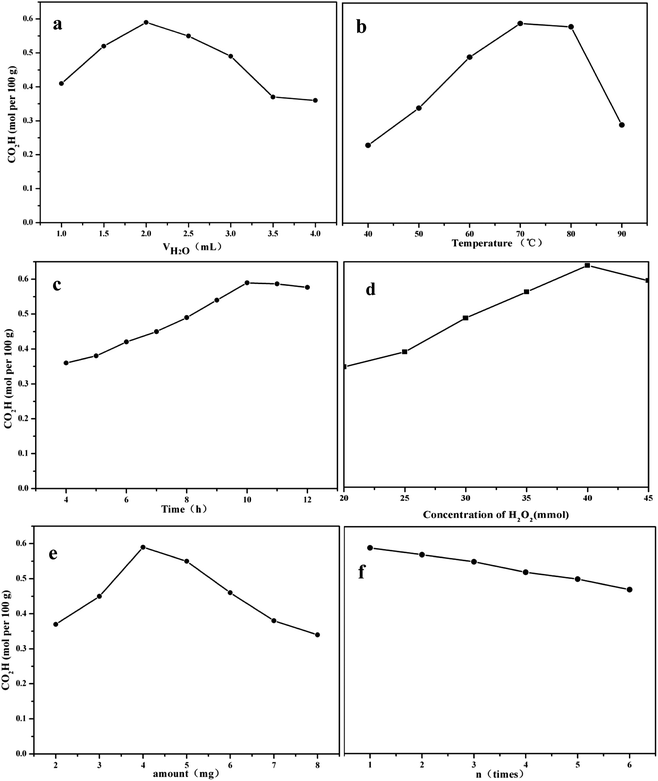 | ||
| Fig. 5 Parameters affecting the oxidation reaction including water content (a), temperature (b), reaction time (c), H2O2 concentration (d), catalyst dosage (e) and reusability (f). | ||
Distilled water (H2O), as the solvent of starch oxidation system, directly influenced the formation of a starch emulsion and transformation to starch solution, then further effected the dispersion of starch molecules around the solid catalyst. Consequently, the H2O content significantly affected the contact of starch molecule with the active site of catalyst, which in turn influenced the catalytic activity. On the other hand, the more water was used, the lower H2O2 concentration was. Thus, water content is a vital factor in starch oxidation. The results in Fig.5a reveal that along with the increase of water content, the carboxyl content of oxidized starch firstly increased until the water content reached to 2 mL, then an obvious decrease was observed. The optimum water content for the highest activity of starch oxidation was 2 mL. The decentralized state of starch in water is provided in Fig S3,† which could be interpreted as the influence of water content. As shown, a stable starch solution was formed as the water content reached 2 mL. Further increasing the water content will lead to the reduction of both the concentration of hydrogen peroxide and the catalyst activity.
The oxidation of starch by H2O2 is supposed to depend on temperature. Fig. 5b shows the carboxyl content of oxidized starch as a function of temperature from 40 to 90 °C. It was observed that from 40 to 70 °C the catalytic activity increased, then remained stable from 70 to 80 °C. Unexpectedly, it decreased sharply between 80 and 90 °C. It is well known that a higher temperature is favourable for the process of starch oxidation, however, further increasing the temperature speeds up the decomposition of H2O2, which reduces the concentration of oxidant and further decreases the reaction rate. In addition, a higher temperature would promote gelatinization of the starch and increase the viscosity of system, thereby decreasing the activity of catalyst. Consequently, the best reaction temperature for starch oxidation was 70 °C.
The reaction time is another important factor for starch oxidation reactions. In a typical reaction protocol, the course of the starch oxidation reaction over time was studied. It can be seen from Fig. 5c, that prolonging the reaction time largely increased the carboxyl content and to a maximum of 0.59 mol per 100 g at 10 h. Further increasing the reaction time did not increase the carboxyl content.
As a predominant factor, the H2O2 concentration significantly affected the oxidation of starch. As seen from Fig. 5d, the carboxyl content in the oxidized starch increased gradually with increasing H2O2 concentration from 20 mmol to 40 mmol and then decreased when the H2O2 concentration reach 45 mmol. We suppose that excessive dosage of H2O2 would lead to the occurrence of side reactions. As a result, 40 mmol of H2O2 can be regarded as the best concentration.
Fig. 5e showed the effect of the catalyst amount on starch oxidation. The experiments were carried out with varying amounts of catalyst between 2 and 8 mg. The carboxyl content increased as the amount of Cs3H2PMo10V2O40 increased. The highest degree of oxidation was obtained with 4 mg catalyst, after which, the carboxyl content decreased sharply with further increasing the amount of catalyst. Furthermore, the color of the oxidized starch turned pale yellow (rather than white) as the amount of catalyst increased beyond 6 mg. Thus, 4 mg of the catalyst was chosen for the best catalyst amount.
3.3 Reusability of the catalyst
The recovered solid catalyst was reused to catalyze the oxidation of starch under the optimal conditions. After each run, the solid Cs3H2PMo10V2O40 was separated from the reaction mixture by simple centrifugation. As clearly shown in Fig. 5f, the degree of oxidation did not decrease significantly after six cycles. According to the IR spectrum (Fig. 1b), the recovered catalyst also retained its parent Keggin structure showing its stability during the reaction. Furthermore, almost no Cs3H2PMo10V2O40 was detected (measured by ICP) in the liquid, indicating that leaching of catalyst was negligible. Therefore, the leaching test showed that Cs3H2PMo10V2O40 had excellent stability and could be reused about six times as a rapid heterogeneous catalyst by simple treatment.3.4 Catalytic mechanism
Taking into account our research on the catalyst activity (detailed above) and related studies reported in the literature,41 the catalytic mechanism of starch oxidation using Cs3H2PMo10V2O40 as a catalyst and H2O2 as an oxidant is proposed as follows (Scheme 1).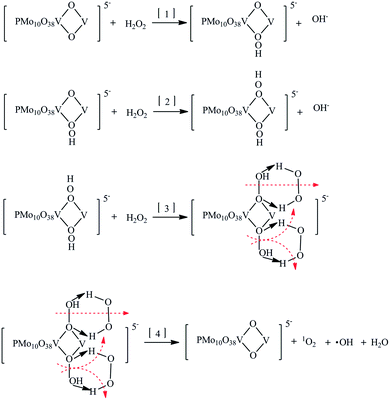 | ||
| Scheme 1 The catalytic mechanism of starch oxidation with H2O2 as oxidant in the presence of Cs3H2PMo10V2O40. | ||
Firstly, one vanadium atom in the POM interacted with hydrogen peroxide to form active intermediates of peroxovanadate and hydroxide (step 1). The formation of peroxovanadate could be identified by UV-vis spectroscopy at 460 nm (Fig. 6I).42 This reaction was repeated by the other vanadium (step 2). These two steps are proton-consuming processes, while the protons in Cs3H2PMo10V2O40 would promote the reaction. Upon further addition of H2O2, the peroxo groups linking the vanadium reacted with H2O2 to generate active intermediates (step 3). This intermediate could then cleave in two ways to generate singlet oxygen and a hydroxyl radical (step 4), while the vanadium POM returns to its original form. Thus the catalytic cycle is completed. As evidence for steps 3 and 4, a quenching experiment was performed with KI, sodium azide (NaN3), and p-benzoquinone (C6H4O2, BQ) as quenchers for the OH˙ radical, singlet oxygen, and superoxide radical respectively. The information obtained (Fig. 6II) illustrates that the loading of KI and NaN3 affect the oxidation of starch throughout the experiment, indicating that the active oxidative species involved in this system were both OH˙ and 1O2. Moreover, the effect of KI was almost twice that of NaN3, which proved that the generation of OH˙ was two times higher than that of 1O2. BQ does not affect the oxidation of starch, showing that O2˙− is not an oxidative intermediate species. These results demonstrated that the reaction takes place through a radical and single oxygen mechanism. Singlet oxygen and the hydroxyl radical attacked the hydroxyl group at the C-2, C-3, and C-6 positions in starch molecules, either oxidizing the hydroxyl group at C-6 position directly to carboxyl or cleaving the band between C-2 and C-3, to form carbonyl and carboxyl.
4. Conclusion
The solid POM catalysts CsxH5−xPMo10V2O40 have been designed and synthesized by controlling the exchange of protons in H5PMo10V2O40 for cesium cations . The surface area and Brønsted acidity could be controlled by adjusting the Cs content. By varying x = 0–5, CsxH5−xPMo10V2O40 exhibited different catalytic activities on the oxidation of starch by H2O2. Among all of the catalysts tested, Cs3H2PMo10V2O40 afforded the most excellent degree of oxidation (0.59 mmol per 100 g, at 70 °C, 10 h) at low catalyst loading. It can be concluded that the Brønsted acidity of these catalysts could promote the oxidation of starch. Meanwhile, the high surface areas of the catalysts also gave the high degrees of oxidation. Moreover, leaching of this solid catalyst was not found to be significant during repeated use, which could allow for reused without further treatment.Acknowledgements
The authors are grateful for the financial support of the National Natural Science Foundation of China (51078066 and 20871026), the project of Jilin Provincial Science and Technology Department (20086035, 20100416, and 201105001) and the National College Students' Innovative Training Program (no. 201210200068).References
- C. L. Hill, C. Chrisina and M. Prosser-McCartha, Coord. Chem. Rev., 1995, 143, 407–455 CrossRef CAS.
- T. Okuhara, N. Mizuno and M. Misono, Adv. Catal., 1996, 41, 113–252 CAS.
- R. Neumann, Inorg. Chem., 2010, 49, 3594–3601 CrossRef CAS PubMed.
- P. Gallezot, ChemSusChem., 2008, 1, 734–737 CrossRef CAS PubMed.
- N. Mizuno and K. Kamata, Coord. Chem. Rev., 2011, 255, 2358–2370 CrossRef CAS PubMed.
- R. Neumann and A. M. Khenkin, Chem. Commun., 2006, 24, 2529–2538 RSC.
- H. Benaissa, P. N. Davey, Y. Z. Khimyak and I. V. Kozhevnikov, J. Catal., 2008, 253, 244–252 CrossRef CAS PubMed.
- (a) M. Akimoto, Y. Tsuchida, K. Sato and E. Echigoya, J. Catal., 1981, 72, 83–94 CrossRef CAS; (b) M. Akimoto, H. Ikeda and E. Echigoya, J. Catal., 1984, 86, 173–186 CrossRef CAS.
- M. Ai, Appl. Catal., 1982, 4, 245–256 CrossRef CAS.
- M. Misono, N. Mizuno and T. Komaya, Proc. 8th Int. Cong. Catal., Verlag Chem, vol. 5, 1984, p. 487 Search PubMed.
- M. Akimoto, H. Ikeda, A. Okabe and E. Echigoya, J. Catal., 1984, 89, 196–208 CrossRef CAS.
- T. Haeberle and G. Emig, Chem. Eng. Technol., 1988, 11, 392–402 CrossRef CAS.
- K. Y. Lee, S. Oishi, H. Igarashi and M. Misono, Catal. Today, 1997, 33, 183–189 CrossRef CAS.
- N. Mizuno, M. Tateishi and M. Iwamoto, J. Catal., 1996, 163, 87–94 CrossRef CAS.
- A. Corma, S. Iborra and A. Velty, Chem. Rev., 2007, 107, 2411–2502 CrossRef CAS PubMed.
- R. L. Whistler and R. Schweiger, J. Am. Chem. Soc., 1959, 81, 3136–3139 CrossRef CAS.
- (a) T. J. Painter, A. Cesàro, F. Delben and S. Paoletti, Carbohydr. Res., 1985, 140, 61–68 CrossRef CAS; (b) K. Engelskirchen, H. Fischer, W. Juettner, H. W. Verholt and T. Moeller, De. Pat., 4402851, 1995transChem. Abstr., 1995, 123, 317408 Search PubMed; (c) T. Moeller, K. Engelkirchen, H. Fischer and W. E. Noack, De. Pat., 19510313, 1996transChem. Abstr., 1996, 125, 279071) Search PubMed; (d) H. Kochkar, M. Morawietz and W. F. Hölderich, Appl. Catal., A, 2001, 210, 325–328 CrossRef CAS; (e) M. Vignon, S. Montanari, D. Samain and J. S. Condoret, Fr. Pat., 2873700, 2006transChem. Abstr. 2006, 144, 151770 Search PubMed.
- (a) M. S. Nieuwenhuizen, A. P. G. Kieboom and H. Van Bekkum, Starch/Staerke, 1985, 37, 192–200 CrossRef CAS; (b) P. Forssell, A. Hamunen, K. Autio, T. Suortti and K. Poutanen, Starch/Staerke, 1995, 47, 371–377 CrossRef CAS; (c) A. C. Besemer and A. E. J. De Nooy, WO. Pat., 07303, 1995transChem. Abstr. 1995, 123, 202726 Search PubMed; (d) A. Teleman, K. Kruus, E. Ämmälahti, J. Buchert and K. Nurmi, Carbohydr. Res., 1999, 315, 286–292 CrossRef CAS.
- W. T. Chong, U. Uthumporn, A. A. Karim and L. H. Cheng, LWT–Food Sci. Technol., 2013, 50, 439–443 CrossRef CAS PubMed.
- P. L. Bragd, A. C. Besemer and H. Van Bekkum, Carbohydr. Polym., 2002, 49, 397–406 CrossRef CAS.
- S. Komulainen, E. Diaz, J. Pursiainen and M. Lajunen, Carbohydr. Res., 2013, 367, 58–62 CrossRef CAS PubMed.
- S. Komulainen, C. Verlackt, J. Pursiainen and M. Lajunen, Carbohydr. Polym., 2013, 93, 73–80 CrossRef CAS PubMed.
- (a) S. Veelaert, D. De Wit and H. Tournois, Polym., 1994, 35, 5091–5097 CrossRef CAS; (b) S. Veelaert, D. De Wit, K. F. Gotlieb and R. Verhé, Carbohydr. Polym., 1997, 33, 153–162 CrossRef CAS; (c) S. Veelaert, D. De Wit, K. F. Gotlieb and R. Verhé, Carbohydr. Polym., 1997, 32, 131–139 CrossRef CAS.
- P. Parovuori, A. Hamunen, P. Forssell, K. Autio and K. Poutanen, Starch/Staerke, 1995, 47, 19–23 CrossRef CAS.
- A. M. Sakharov, N. T. Silakhtarnyan and I. P. Skibida, Kinet. Catal., 1996, 37, 368–372 CAS.
- M. Floor, K. M. Schenk, A. P. G. Kieboom and H. Van Bekkum, Starch/Staerke, 1989, 41, 303–309 CrossRef CAS.
- S. R. Collinson and W. Thielemans, Coord. Chem. Rev., 2010, 254, 1854–1870 CrossRef CAS PubMed.
- (a) S. Alexander, G. Pierre and S. L. Kachkarova-Sorokina, Fr. Pat., 2842200, 2004transChem. Abstr. 2004, 140, 95825 Search PubMed; (b) S. L. Kachkarova-Sorokina, P. Gallezot and A. B. Sorokin, Chem. Commun., 2004, 24, 2844–2845 RSC.
- C. Aouf, D. Harakat, J. Muzart, B. Estrine, S. Marinkovic, C. Ernenwein and J. L. Bras, ChemSusChem., 2010, 3, 1200–1203 CrossRef CAS PubMed.
- M. Floor, K. M. Schenk, A. P. G. Kieboom and H. Van Bekkum, Starch/Staerke, 1989, 41, 303–309 CrossRef CAS.
- X. L. Chen, B. Souvanhthong, H. Wang, H. W. Zheng, X. H. Wang and M. H. Huo, Appl. Catal., B, 2013, 138–139, 161–166 CrossRef CAS PubMed.
- J. Xu, B. L. Mojet, J. G. van Ommen and L. Lefferts, J. Catal., 2005, 232, 411–423 CrossRef CAS PubMed.
- G. A. Tsigdinos and C. J. Hallada, Inorg. Chem., 1968, 7, 437–441 CrossRef CAS.
- T. Okayasu, K. Saito, H. Nishide and M. T. W. Hearn, Green Chem., 2010, 12, 1981–1989 RSC.
- S. Suganuma, K. Nakajima and M. Kitano, J. Am. Chem. Soc., 2008, 130, 12787–12793 CrossRef CAS PubMed.
- T. Rajkumar and G. R. Rao, J. Chem. Sci., 2008, 120, 587–594 CrossRef CAS.
- F. Chai, D. L. Li, H. B. Wu, C. Zhang and X. H. Wang, J. Solid State Chem., 2009, 182, 1661–1665 CrossRef CAS PubMed.
- S. Komulainen, E. Diaz, J. Pursiainen and M. Lajunen, Carbohydr. Res., 2013, 367, 58–62 CrossRef CAS PubMed.
- L. J. Csányi, J. Mol. Catal. A: Chem., 2010, 322, 1–6 CrossRef PubMed.
- C. Marchal-Roch, N. Laronze, N. Guillou, A. Tézé and G. Hervé, Appl. Catal., A, 2000, 199, 33–44 CrossRef CAS.
- A.-C. B. Salomonsson, R. E. Andersson, L. J. Torneport and O. Theander, Carbohydr. Res., 1991, 217, 221–225 CrossRef CAS.
- P. P. Zhao, J. Wang, G. J. Chen, Y. Zhou and J. Huang, Catal. Sci. Technol., 2013, 3, 1394–1404 CAS.
Footnote |
| † Electronic supplementary information (ESI) available. See DOI: 10.1039/c3ra47122e |
| This journal is © The Royal Society of Chemistry 2014 |


